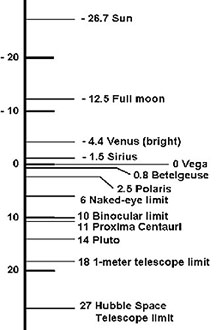
Magnitudes of Selected Objects
The method we use today to compare the apparent brightness (magnitude) of stars began with Hipparchus, a Greek astronomer who lived in the second century BC. Hipparchus called the brightest star in each constellation "first magnitude." Ptolemy, in 140 A.D., refined Hipparchus' system and used a 1 to 6 scale to compare star brightness, with 1 being the brightest and 6 the faintest. This is similar to the system used in ranking tennis players, etc. First rank is better than second, etc. Unfortunately, Ptolemy did not use the brightest star, Sirius, to set the scale, so it has a negative magnitude. (Imagine being ranked -1.5 in the tennis rankings!)
Astronomers in the mid-1800's quantified these numbers and modified the old Greek system. Measurements demonstrated that 1st magnitude stars were 100 times brighter than 6th magnitude stars. It has also been calculated that the human eye perceives a one-magnitude change as being 2 and ½ times brighter, so a change in 5 magnitudes would seem to be 2.5 to the fifth power (or approximately 100) times brighter. Therefore a difference of 5 magnitudes has been defined as being equal to a factor of exactly 100 in apparent brightness.


